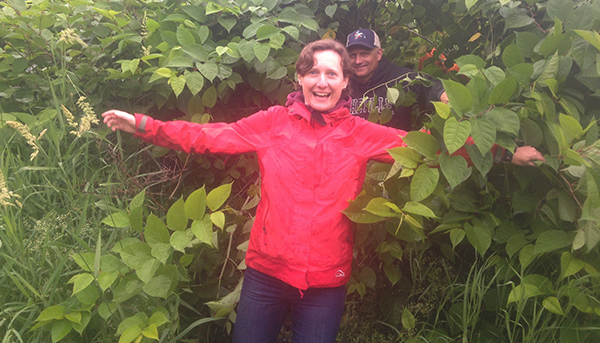The Waitsfield Conservation Commission recently met with contractors and organizations involved in the Austin Parcel flood plain forest restoration, involving removal of invasive plant species and planting of native trees and shrubs in 2018 and 2019. Under direction of the Waitsfield Select Board, the commission is responsible for managing this parcel of town land for flood plain restoration and other public purposes.
The commission welcomed representatives of the Intervale Conservation Nursery (ICN), Friends of the Mad River (FMR), and Mad River Path Association (MRPA) to its December meeting. These three organizations had submitted a written summary of 2018 activities and progress, available at http://waitsfieldvt.us/conservation-commission/ under Austin Parcel Annual Impact Report 2018.
The Austin Parcel is about 5 acres just south of the Lareau swim hole on Route 100. It had previously been managed as pasture or hayfield, but after Tropical Storm Irene in 2011 and the town-approved Wu Ledges Management Plan development, it was dedicated to flood plain restoration.
TOUGH PROJECT
“We are through the first year of the two-year Austin Parcel contract with the Intervale Conservation Nursery and local partners, and the December meeting was an important chance to review the completed work together and plan for the second year,” said commission chair Phil Huffman. “It’s a tough project in that the invasive species – particularly Japanese knotweed – are aggressive and, in order for the planted trees and shrubs to have the best survivorship, we need to clear and dispose of the knotweed, which we are accomplishing only with manual and mechanical methods.”
In early 2018, the commission issued a request for proposals for support work to implement its goals, including mechanical knotweed suppression, subsequent to which the commission hired ICN, with FMR and MRPA as local subcontractors.
“We appreciate the opportunity to help show the public how riverside flood plain forest can be restored despite the highly invasive nature of Japanese knotweed,” said ICN’s Mike Ingalls. “We conducted several days of conservation stewardship with our staff and a stewardship day in late October with members of the public. I have been pleased with the results, including planting hundreds of trees and shrubs in the restoration project area.”
LOOKING FORWARD
“We’re looking forward to working with the community in 2019 to care for the 200 trees and shrubs we planted together in October and get more plants in the ground,” said Corrie Miller, Friends of the Mad River executive director. “A flourishing riparian forest will add to our quality of life here in the Mad River Valley and benefit wildlife habitat in and around the river.” The reforestation project relies on trees and shrubs supplied by Friends of the Mad River and the U.S. Fish and Wildlife Service’s Partners for Fish and Wildlife program.
“Suppression of the knotweed is a big challenge,” according to David Hodgson, the Mad River Path’s trail and projects manager, who has been contracted to whack knotweed weekly through the summers of 2018 and 2019.
“If you stand still in early summer, you can almost see the knotweed growing. And if you don’t want to use chemicals to control it, especially so close to the river, as our community has decided, it means years and years of weed-whacking with power tools or scythes. We made a lot of progress this year.”
The whacking regime is likely to continue for years after the expiration of the contract and provides a model for knotweed suppression by landowners throughout the Mad River Valley. In 2019 MRPA board member Rocky Bleier will offer scything demonstrations for knotweed control.
DEMONSTRATION FOREST
Next year’s program will continue invasives removal and management as well as further planting to create a demonstration flood plain forest. It will also feature new signage and a loop trail as part of the Mad River Path system. The loop walk is already popular with walkers and runners.
There will be community stewardship days in spring and fall 2019. The 2018 community stewardship day was successful, despite the onset of a snowstorm. Spirits were high and 200 trees and shrubs were planted on the Austin Parcel. The commission and contractors hope that the public who opposed the use of chemical treatments on the parcel will participate in the community stewardship days in 2019. To receive notification of community stewardship opportunities at the Austin Parcel, contact Mark Haberle of the commission’s







